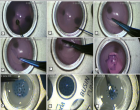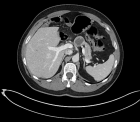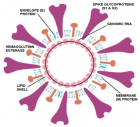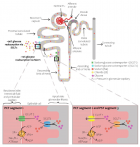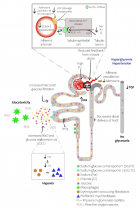Figure 3
SGLT2 Inhibitors and nephroprotection in diabetic kidney disease: From mechanisms of action to the latest evidence in the literature
Jorge Rico-Fontalvo, Rodrigo Daza-Arnedo, Maria Ximena Cardona-Blanco, Victor Leal-Martínez, Emilio Abuabara-Franco, Nehomar Pajaro-Galvis*, Jose Cabrales, José Correa, Manuel Cueto, Amable Duran, Alejandro Castellanos, Javier Enamorado, José Bohórquez, Isabella Uparella, Julio Zuñiga, Abraham Chagui, Alfonso Ramos and Luis Lara
Published: 21 August, 2020 | Volume 4 - Issue 2 | Pages: 044-055
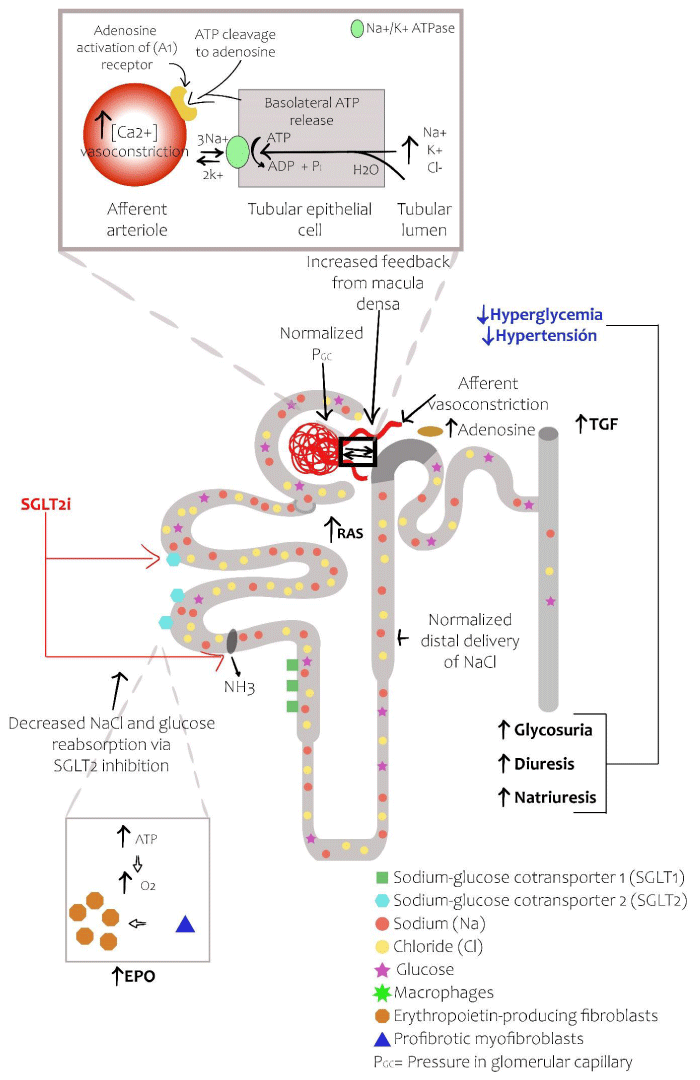
Figure 3:
Effects of SGLT2 inhibitors in the diabetic nephron. SGLT2 inhibitors restore the delivery of solutes to the macular densa with the subsequent activation of adenosine and the reversal of the vasodilatation of the afferent arteriole. In patients treated with SGLT2 inhibitors, glucosuria, natriuresis and osmotic diuresis reduce the levels of glucose in the blood and lower blood pressure. By inhibiting the reabsorption of sodium at the level of SGLT2 as well as the sodium-hydrogen exchanger, the SGLT2 inhibitors restore the GFR with a decrease in the glomerular capillary pressure. The reduced reabsorption of glucose decreases local glucose toxicity. The improvement of the hypoxia in the renal cortex allows for differentiation of myofibroblasts in the EPO producing cells, reducing renal fibrosis and increasing EPO production [3,5].
Read Full Article HTML DOI: 10.29328/journal.jcn.1001058 Cite this Article Read Full Article PDF
More Images
Similar Articles
-
Anemia response to Methoxy Polyethylene Glycol-Epoetin Beta (Mircera) versus Epoetin Alfa (Eprex) in patients with chronic Kidney disease on HemodialysisAlaa K Dhayef*,Jawad K Manuti,Abdulwahab S Abutabiekh. Anemia response to Methoxy Polyethylene Glycol-Epoetin Beta (Mircera) versus Epoetin Alfa (Eprex) in patients with chronic Kidney disease on Hemodialysis. . 2017 doi: 10.29328/journal.jcn.1001006; 1: 041-047
-
Complete recovery of chronic Osmotic Demyelination Syndrome with plasma exchangeSumbal Nasir Mahmood*,Kunwer Naveed Mukhtar,Osama Kunwer Naveed,Ahmed Kunwer Naveed. Complete recovery of chronic Osmotic Demyelination Syndrome with plasma exchange. . 2018 doi: 10.29328/journal.jcn.1001011; 2: 005-007
-
A case report of Hypocomplementemic urticarial vasculitic syndrome presenting with Renal failureAmy M Hopkins,Angela M Gibbs,Ryan S Griffiths,Rupali S Avasare,Firas G Khoury*. A case report of Hypocomplementemic urticarial vasculitic syndrome presenting with Renal failure. . 2018 doi: 10.29328/journal.jcn.1001017; 2: 039-043
-
Relationship between Fetuin-A and vascular or valvular calcification in hemodialysis patientsShahrzad Ossareh*,Bahareh Marghoob,Robabeh Bayat. Relationship between Fetuin-A and vascular or valvular calcification in hemodialysis patients. . 2019 doi: 10.29328/journal.jcn.1001021; 3: 001-011
-
Chronic kidney disease in women: a cross sectional screening in a tertiary care hospital in VaranasiRai Pradeep K*,Rai Punam,Bedi Sonam. Chronic kidney disease in women: a cross sectional screening in a tertiary care hospital in Varanasi . . 2019 doi: 10.29328/journal.jcn.1001022; 3: 012-018
-
Anti-Inflammatory probiotic biomarkers in Fermented foodsFarid E Ahmed*,Nancy C Ahmed . Anti-Inflammatory probiotic biomarkers in Fermented foods . . 2019 doi: 10.29328/journal.jcn.1001023; 3: 019-041
-
Chronic Kidney Disease: A single day screening on World Kidney Day for five consecutive yearsRai Pradeep K*,Rai Punam,Bedi Sonam. Chronic Kidney Disease: A single day screening on World Kidney Day for five consecutive years. . 2019 doi: 10.29328/journal.jcn.1001025; 3: 046-054
-
Challenges of haemodialysis: A single centre experience in South West NigeriaSamuel Ayokunle Dada*,Adebukola Bidemi Ajite,Funmilayo Abimbola Ibitoba,Awolowo Anthony Thomas,Oluwamayowa Esther Dada,Olabisi Olamide Deji-Dada. Challenges of haemodialysis: A single centre experience in South West Nigeria . . 2019 doi: 10.29328/journal.jcn.1001026; 3: 055-060
-
Anti-glomerular basement membrane disease: A case report of an uncommon presentationNatália Silva*,Luís Oliveira,Mónica Frutuoso,Teresa Morgado. Anti-glomerular basement membrane disease: A case report of an uncommon presentation. . 2019 doi: 10.29328/journal.jcn.1001027; 3: 061-065
-
Peritonitis: Culprit for peritoneal dialysis declineKishore Kumar*,Jais Kumar,Chaudhri Naureen. Peritonitis: Culprit for peritoneal dialysis decline . . 2019 doi: 10.29328/journal.jcn.1001028; 3: 066-070
Recently Viewed
-
Impact of Chronic Kidney Disease on Major Adverse Cardiac Events in Patients with Acute Myocardial Infarction: A Retrospective Cohort StudyAbbas Andishmand, Ehsan Zolfeqari*, Mahdiah Sadat Namayandah, Hossein Montazer Ghaem. Impact of Chronic Kidney Disease on Major Adverse Cardiac Events in Patients with Acute Myocardial Infarction: A Retrospective Cohort Study. J Cardiol Cardiovasc Med. 2024: doi: 10.29328/journal.jccm.1001175; 9: 029-034
-
Myxedema Coma and Acute Respiratory Failure in a Young Child: A Case ReportRinah Elaisse R Dolores, Marion O Sanchez*. Myxedema Coma and Acute Respiratory Failure in a Young Child: A Case Report. Ann Clin Endocrinol Metabol. 2023: doi: 10.29328/journal.acem.1001027; 7: 008-013
-
A General Evaluation of the Cellular Role in Drug Release: A Clinical Review StudyMohammad Hossein Karami* and Majid Abdouss*. A General Evaluation of the Cellular Role in Drug Release: A Clinical Review Study. Clin J Obstet Gynecol. 2024: doi: 10.29328/journal.cjog.1001162; 7: 042-050
-
Are Biofungicides a Means of Plant Protection for the Future?Radek Vavera*, Josef Hýsek. Are Biofungicides a Means of Plant Protection for the Future?. J Plant Sci Phytopathol. 2024: doi: 10.29328/journal.jpsp.1001130; 9: 041-042
-
CVS: An Effective Strategy to Prevent Bile Duct InjurySardar Rezaul Islam*, Debabrata Paul, Shah Alam Sarkar, Mohammad Hanif Emon, Tania Ahmed. CVS: An Effective Strategy to Prevent Bile Duct Injury. Arch Surg Clin Res. 2024: doi: 10.29328/journal.ascr.1001080; 8: 027-031
Most Viewed
-
Evaluation of Biostimulants Based on Recovered Protein Hydrolysates from Animal By-products as Plant Growth EnhancersH Pérez-Aguilar*, M Lacruz-Asaro, F Arán-Ais. Evaluation of Biostimulants Based on Recovered Protein Hydrolysates from Animal By-products as Plant Growth Enhancers. J Plant Sci Phytopathol. 2023 doi: 10.29328/journal.jpsp.1001104; 7: 042-047
-
Feasibility study of magnetic sensing for detecting single-neuron action potentialsDenis Tonini,Kai Wu,Renata Saha,Jian-Ping Wang*. Feasibility study of magnetic sensing for detecting single-neuron action potentials. Ann Biomed Sci Eng. 2022 doi: 10.29328/journal.abse.1001018; 6: 019-029
-
Physical activity can change the physiological and psychological circumstances during COVID-19 pandemic: A narrative reviewKhashayar Maroufi*. Physical activity can change the physiological and psychological circumstances during COVID-19 pandemic: A narrative review. J Sports Med Ther. 2021 doi: 10.29328/journal.jsmt.1001051; 6: 001-007
-
Pediatric Dysgerminoma: Unveiling a Rare Ovarian TumorFaten Limaiem*, Khalil Saffar, Ahmed Halouani. Pediatric Dysgerminoma: Unveiling a Rare Ovarian Tumor. Arch Case Rep. 2024 doi: 10.29328/journal.acr.1001087; 8: 010-013
-
Prospective Coronavirus Liver Effects: Available KnowledgeAvishek Mandal*. Prospective Coronavirus Liver Effects: Available Knowledge. Ann Clin Gastroenterol Hepatol. 2023 doi: 10.29328/journal.acgh.1001039; 7: 001-010

HSPI: We're glad you're here. Please click "create a new Query" if you are a new visitor to our website and need further information from us.
If you are already a member of our network and need to keep track of any developments regarding a question you have already submitted, click "take me to my Query."








